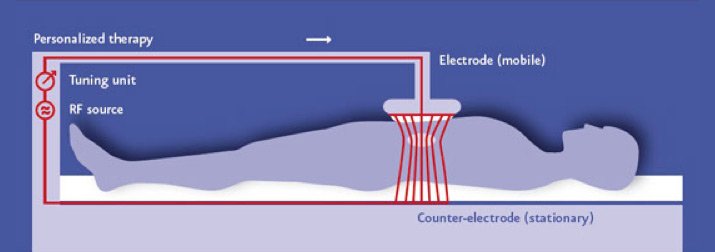Hyperthermia is the principle of heating a body tissue to high temperatures. By heating the body, indicated solid tumours can become more receptive to conventional treatments such as radiation and chemotherapy. Long periods of heating increases blood flow to the tumour and oxygenation, as well as protein changes within the tumour. This help sensitizes tumours, making them more receptive to chemotherapy and radiation. Research has also shown that high temperatures can damage and kill cancer cells, usually with minimal injury to normal tissues. Loco-Regional Hyperthermia (LRHT) takes this principle one step further by concentrating that heat only on tumour cells. It does this through a delivery method that selectively delivers a controlled energy dose to a localized treatment area. Because tumour cells have different cell walls than healthy cells, they alone are susceptible to this treatment.

Loco-Regional Hyperthermia is designed to selectively heat targeted cancer tissue to higher temperatures in a safe and controlled manner.
Microbiological tests have demonstrated that in a malignant tumour cell, the ionic (electrolyte) concentrations in the outermost layer are very different from healthy cells. Consequently, the malignant cell has greater electrical conductivity and permittivity than healthy cells. The greater conductivity of tumour cells allows the radio-frequency (RF) field current to flow predominantly through the tumour cells, and the resulting concentration of energy selectively heats the malignant cells to temperatures greater than 42°C, while leaving surrounding healthy tissue unharmed.
Loco-Regional Hyperthermia is designed to selectively heat targeted cancer tissue to higher temperatures in a safe and controlled manner.
Microbiological tests have demonstrated that in a malignant tumour cell, the ionic (electrolyte) concentrations in the outermost layer are very different from healthy cells. Consequently, the malignant cell has greater electrical conductivity and permittivity than healthy cells. The greater conductivity of tumour cells allows the radio-frequency (RF) field current to flow predominantly through the tumour cells, and the resulting concentration of energy selectively heats the malignant cells to temperatures greater than 42°C, while leaving surrounding healthy tissue unharmed.
Localized heating of the tissue has several supportive effects on malignant cells:
Hyperthermia is safe for both patients and operators. There is no systemic increase in body temperature as it is an adjunctive Loco-Regional Electro-Modulated heating application. The patient will feel comfortable throughout the procedure. Continuous monitoring throughout treatment by our doctors and staff ensure that patient comfort is maximal. Effects from treatment are usually restricted to a temporary surface reddening of the skin.
Loco-Regional Hyperthermia is meant to be used as an adjunct with other therapies supporting conventional care.
At HealthSource Integrative Medical Centre, Dr Michael Reid, Naturopathic Doctor and Fellow of the American Board of Naturopathic Oncology, evaluates all your information to tailor a plan that is designed specifically for you. He strategically integrates evidence-informed therapies to guide candidates about supportive therapies available to them.